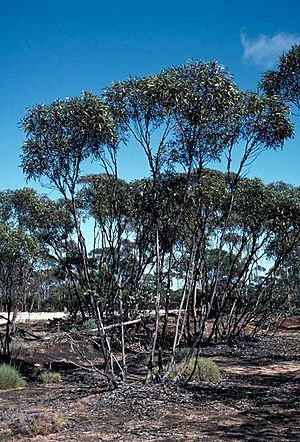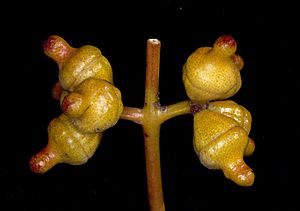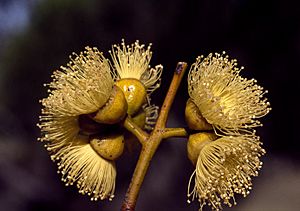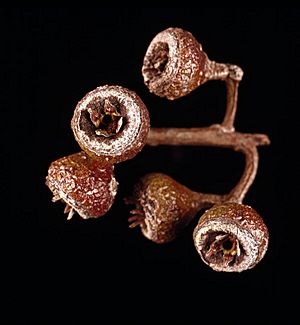Balladonia mallee facts for kids
Quick facts for kids Balladonia mallee |
|
|---|---|
 |
|
| Eucalyptus balladoniensis growing near Balladonia | |
| Scientific classification | |
| Genus: |
Eucalyptus
|
| Species: |
balladoniensis
|
The Eucalyptus balladoniensis, commonly known as the Balladonia mallee, is a special type of mallee tree. A mallee is a shrubby tree with many stems growing from a woody base. This plant is found only in a specific area in the south of Western Australia. It has rough bark on the lower half of its stems and smooth, brownish bark higher up. It also has lance-shaped leaves, flower buds that grow in groups of seven, pale yellow flowers, and round or half-round fruits.
Contents
What is the Balladonia Mallee?
The Balladonia mallee is a type of Eucalyptus tree that usually grows to be about 2.5 to 10 meters (8 to 33 feet) tall. It has rough, dark grey bark that feels like fiber or flakes on the lower part of its stems. Higher up, the bark is smooth and dark grey. When this bark peels off in short strips, it shows smooth, brownish bark underneath.
Young plants and new shoots that grow after a fire (called coppice regrowth) have dull, greyish-green leaves. These leaves are long and narrow, about 10 to 15 centimeters (4 to 6 inches) long and 0.6 to 2 centimeters (0.2 to 0.8 inches) wide. As the plant gets older, its leaves become lance-shaped. Adult leaves are about 7 to 13.5 centimeters (2.8 to 5.3 inches) long and 1 to 2.7 centimeters (0.4 to 1.1 inches) wide. They grow on a stalk called a petiole, which is about 1.2 to 2.5 centimeters (0.5 to 1 inch) long.
How Do Its Flowers and Fruits Look?
The flowers of the Balladonia mallee grow in groups of seven. They appear in the axils of the leaves, which is the angle between a leaf and the stem. Each group of flowers grows on a stalk called a peduncle, which is about 1 to 2 centimeters (0.4 to 0.8 inches) long. The individual flower buds can either sit directly on the stem (sessile) or have a small stalk called a pedicel, which is about 0.5 to 1.1 centimeters (0.2 to 0.4 inches) long.
When the buds are ready to open, they are mostly round. They are about 1.9 to 2.5 centimeters (0.7 to 1 inch) long and 0.9 to 1.1 centimeters (0.4 to 0.4 inches) wide. They have a beak-like cap, called an operculum, which becomes less noticeable as the bud grows. The Balladonia mallee mainly flowers from August to October, and its flowers are pale yellow.
After the flowers bloom, they turn into a woody fruit. This fruit is a round or half-round capsule, about 0.7 to 1.1 centimeters (0.3 to 0.4 inches) long and 1 to 1.4 centimeters (0.4 to 0.6 inches) wide.
Where Does the Balladonia Mallee Live?
The Balladonia mallee grows in dry woodlands. You can often find it on sandy hills or in sandy soil that contains calcium carbonate.
There are two main types, or subspecies, of the Balladonia mallee:
- The first type, Eucalyptus balladoniensis subspecies balladoniensis, is found widely south of the Eyre Highway. Its flower buds have a pedicel (small stalk) that is 0.5 to 1.1 centimeters (0.2 to 0.4 inches) long. Its fruits have a pedicel that is 0.6 to 1.6 centimeters (0.2 to 0.6 inches) long.
- The second type, Eucalyptus balladoniensis subspecies sedens, is only found between Balladonia and Zanthus. Its buds and fruits either sit directly on the stem (sessile) or have a very short pedicel.
Who Discovered and Named It?
The Balladonia mallee was first officially described in 1976 by a scientist named Ian Brooker. He found a sample of the plant about 80 kilometers (50 miles) south of Zanthus, on the road to Balladonia. His description was published in a science journal called Nuytsia.
The plant's scientific name, balladoniensis, refers to where it is found. The ending -ensis is a Latin suffix that means "from a place or country."
Is the Balladonia Mallee Endangered?
Good news! Both types of the Balladonia mallee are considered "not threatened" by the Western Australian Government's Department of Parks and Wildlife. This means they are not currently at risk of disappearing.




